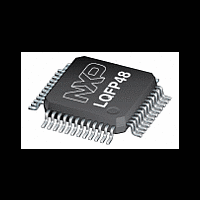LPC11C22FBD48 NXP Semiconductors, LPC11C22FBD48 Datasheet - Page 25

LPC11C22FBD48
Manufacturer Part Number
LPC11C22FBD48
Description
The LPC11C22FBD48 is an ARM Cortex-M0 microcontroller designed for 8/16-bit microcontroller applications, offering performance, low power, simple instruction set and memory addressing together with reduced code size compared to existing 8/16-bit arch
Manufacturer
NXP Semiconductors
Datasheet
1.LPC11C12FBD48.pdf
(62 pages)
Available stocks
Company
Part Number
Manufacturer
Quantity
Price
Company:
Part Number:
LPC11C22FBD48
Manufacturer:
VISHAY
Quantity:
60
Company:
Part Number:
LPC11C22FBD48/301
Manufacturer:
MAXIM
Quantity:
560
Company:
Part Number:
LPC11C22FBD48/301,
Manufacturer:
NXP Semiconductors
Quantity:
10 000
Part Number:
LPC11C22FBD48/30115
Manufacturer:
NXP/恩智浦
Quantity:
20 000
NXP Semiconductors
LPC11CX2_CX4
Product data sheet
7.16.5.2 Deep-sleep mode
7.16.5.3 Deep power-down mode
7.17.1 Start logic
7.17.2 Reset
7.17.3 Brownout detection
7.17 System control
In Deep-sleep mode, the chip is in Sleep mode, and in addition all analog blocks are shut
down. As an exception, the user has the option to keep the watchdog oscillator and the
BOD circuit running for self-timed wake-up and BOD protection. Deep-sleep mode allows
for additional power savings.
Up to 13 pins total, see
to wake up the chip from Deep-sleep mode.
Unless the watchdog oscillator is selected to run in Deep-sleep mode, the clock source
should be switched to IRC before entering Deep-sleep mode, because the IRC can be
switched on and off glitch-free.
In Deep power-down mode, power is shut off to the entire chip with the exception of the
WAKEUP pin. The LPC11Cx2/Cx4 can wake up from Deep power-down mode via the
WAKEUP pin.
When entering Deep power-down mode, an external pull-up resistor is required on the
WAKEUP pin to hold it HIGH. The RESET pin must also be held HIGH to prevent it from
floating while in Deep power-down mode.
The start logic connects external pins to corresponding interrupts in the NVIC. Each pin
shown in
vector table. The start logic pins can serve as external interrupt pins when the chip is
running. In addition, an input signal on the start logic pins can wake up the chip from
Deep-sleep mode when all clocks are shut down.
The start logic must be configured in the system configuration block and in the NVIC
before being used.
Reset has four sources on the LPC11Cx2/Cx4: the RESET pin, the Watchdog reset,
power-on reset (POR), and the BrownOut Detection (BOD) circuit. The RESET pin is a
Schmitt trigger input pin. Assertion of chip reset by any source, once the operating voltage
attains a usable level, starts the IRC and initializes the flash controller.
When the internal Reset is removed, the processor begins executing at address 0, which
is initially the Reset vector mapped from the boot block. At that point, all of the processor
and peripheral registers have been initialized to predetermined values.
An external pull-up resistor is required on the RESET pin if Deep power-down mode is
used.
The LPC11Cx2/Cx4 includes four levels for monitoring the voltage on the V
voltage falls below one of the four selected levels, the BOD asserts an interrupt signal to
the NVIC. This signal can be enabled for interrupt in the Interrupt Enable Register in the
Table 3
All information provided in this document is subject to legal disclaimers.
as input to the start logic has an individual interrupt in the NVIC interrupt
Table
Rev. 3 — 27 June 2011
3, serve as external wake-up pins to a dedicated start logic
32-bit ARM Cortex-M0 microcontroller
LPC11Cx2/Cx4
© NXP B.V. 2011. All rights reserved.
DD
pin. If this
25 of 62















